Palestinian Central Bureau of Statistics (PCBS)
On the Eve of World Elderly Day 1/10/2015
The Palestinian Central Bureau of Statistics presents this release about the situation of the elderly 60 years and over in the occasion of the international elderly day October 1st.
Elderly People in Palestine represent 4.5% of the total population in mid 2015
The Palestinian society is considered a young society where the percentage of children is high and the percentage of the elderly is relatively little. In mid of the year 2015, the percentage of the elderly aged 60 and over reached 4.5% of the population in Palestine (4.9% in West Bank and 3.8% in Gaza strip). Even though, the percentage of the elderly will be increasing during the coming years in Palestine, their percentage will stay relatively low not exceeding 4.5% during the current decade. The elderly percentage may start increasing after year 2020.
Palestine witnesses improvement in life expectancy since the beginning of the last two decades. Life expectancy has increased about 5-8 years during the last two decades. In particular life expectancy increased for both males and females from 67.0 years in 1992 to 72.0 years for males and 75.0 years for females in mid of the year 2015. The life expectancy is expected to increase during the coming years to reach 72.8 years for males and 75.7 years for females in the year 2020. The increase of life expectancy rate at birth resulted in the increase of the elderly number in Palestine which requires studying and researching the elderly situation in Palestine.
Distribution of Population in Palestine by Age Groups, Mid-2015
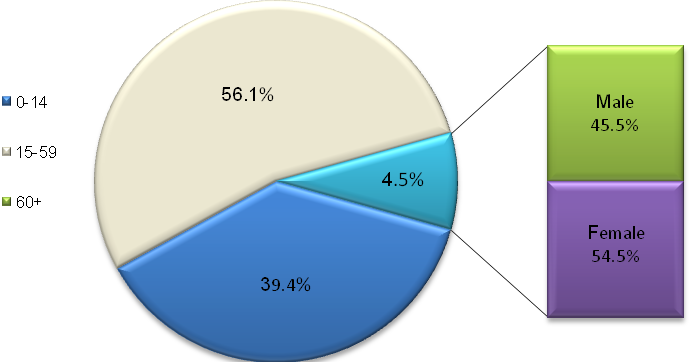
Increase of females percentage against males percentage
The percentage of males aged 60 and over in Palestine reached about 4.0% in 2015 against 5.0% for females with sex ratio 83.6 males against 100 females.
One household out of six households is headed by an elderly person
The percentage of households headed by an elderly person in the 2nd quarter of 2015 reached 16.3% in Palestine (17.6% in West Bank and 13.9% in Gaza Strip). The data indicates that the average size of the households headed by an elderly person is relatively small reached 3.3 individuals (3.1 in West Bank and 4.2 in Gaza Strip), against 5.3 for the households not presided over headed by an elderly person in the 2nd quarter of 2015.
Average of Household Size Headed by an Elderly Person in Palestine by Region,
the 2nd Quarter of the year 2015
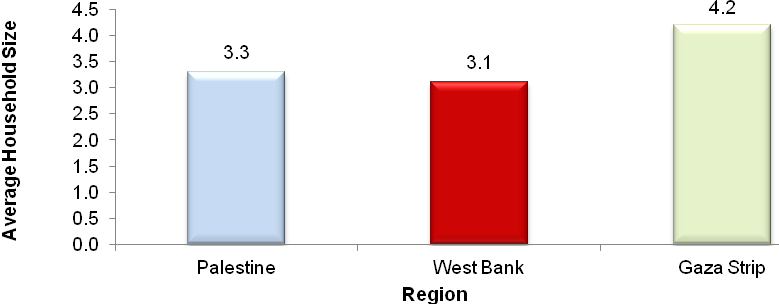
About Half of elderly females are widows
About 90.6% of the elderly males in Palestine are married against 42.7% of the elderly females are married. The percentage of the elderly widowed males reached 8.4% against 49.0% for females in the 2nd quarter of the year 2015.
More than half of the working elderly are self-employed
The percentage of the elderly aged 60 and over participation in the labor force reached about 13.4% of the total elderly in Palestine during 2nd quarter of 2015, (16.1% in West Bank and 7.7% in Gaza strip). The unemployed rate of elderly in Palestine reached 1.1% (0.9% in West Bank and 1.7% in Gaza strip). The unemployed rate of elderly males reached 2.5%. Data also indicates that 53.6% of the working elderly are self-employed; while 15.2% are paid employees.
Labour Force Participation and Unemployment rate for Elderly in Palestine 2nd Quarter 2015
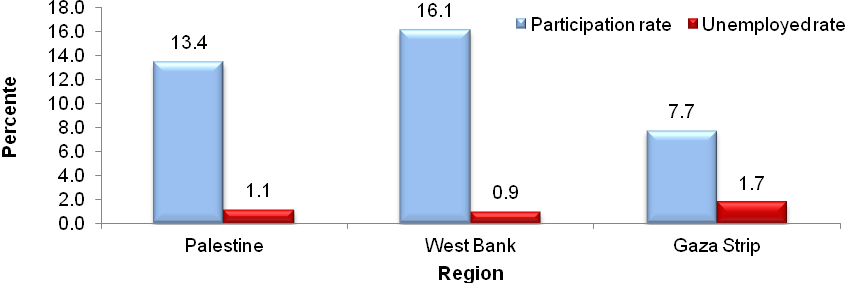
High percentage of illiterate elderly in 2014
Data indicates that there is a high percentage of illiterate elderly in 2014. The percentage of the elderly who have not completed any educational stage reached 52.7% (33.8% males and 68.1% females), and the percentage of illiteracy for elderly is 32.3% of the total elderly persons. They represent about 67.2% of the illiterate persons in Palestine.
Percentage Distribution of Persons (15 years and over) Illiterate by age Group, 2014
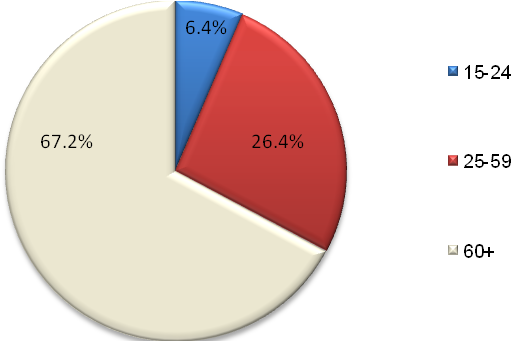
The percentage of the elderly who obtained diploma and higher is 11.1% in Palestine. Data on illiteracy of 2014 indicates that there is an obvious difference between males and females in receiving education where the percentage of the elderly males who have obtained a diploma and higher reached 18.5% against 5.0% for elderly females. Needless to note that the illiteracy percentage of individuals aged 15 and over does not exceed 3.6% (1.6% males against 5.6% females). The percentage of individuals aged 15 and over who obtained diploma and higher reached 17.5% of total population aged 15 and over in Palestine (17.6% males and 17.5% females).
Prevalence of chronic diseases among the elderly
The Palestinian Family Survey 2010 data indicates that 70.7% of the elderly aged 60 and over are infected with at least one chronic disease (71.6% in West Bank and 68.7% in Gaza strip) in Palestine. The data indicated that females are more infected with 75.4% against 64.7% males.
Percentage of the Prevalence of Chronic Diseases Among the Elderly by Region, 2010
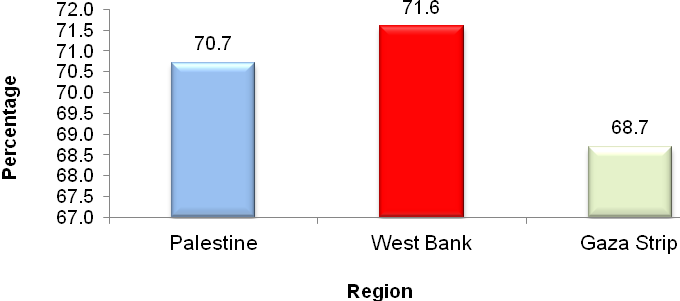
 عربي
عربي